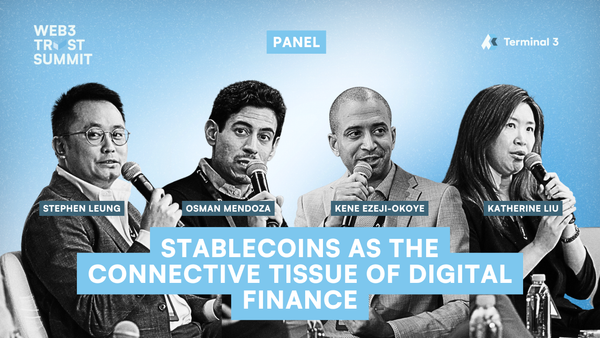Stablecoins: The essential but controversial bridge between crypto and stability

GM,
This week’s issue is the final in our series into how the Web3 space is maturing in 2024. We previously looked in detail at the arrival of US ETFs and the trillion-dollar opportunity of RWA (Real World Assets). Up next is stablecoins.
These are hugely influential assets that will play a massive role in the future of Web3. Tether, the world’s top stablecoin, is traded more than any other crypto asset and its value combined with the number two stablecoin (USDC) is approximately US$125 billion.
We’d like to wish a Happy Lunar New Year to all of our readers, may the Year of the Dragon bring you prosperity!
Best,
What’s going on?
Cryptocurrencies may be about stoking the ideal of retiring from a single trade, but one of the key pieces of the industry is far more mundane: stablecoins.
These digital assets are pegged to the US dollar or other fiat currencies to ensure that they provide stability for your money. But the spectacular implosion of Luna nearly two years ago—which liquidated tens of billions in assets—plus the shady uncertainties of today’s largest issuer of stablecoins means there’s still plenty of concern.
There will soon be a day when you can simply swap your fiat currency for a stablecoin with your bank directly. But, for that to happen, expect plenty of regulation and a lot more clarity.
SO WHAT?
1. Anchors in a sea of volatility
They may not be sexy or exciting, but stablecoins are an essential bridge between the volatile world of cryptocurrencies and the stability of traditional fiat currencies. Unlike Bitcoin, Ethereum, or other cryptocurrencies that can see values wildly in short periods, stablecoins aim to maintain a steady value—typically mirroring fiat currencies like the US dollar.
Traders use them as dry powder storage between trades, and they are essential landing mats for on-ramping and off-ramping fiat currencies into digital assets. But not all stablecoins are created equally:
Fiat-collateralized stablecoins are backed by reserves of fiat currency held in a bank account. For every stablecoin issued, there should be a corresponding amount of fiat currency held in reserve.
Crypto-collateralized are like the above, but they are backed by cryptocurrencies like Bitcoin or Ethereum. This model relies on overcollateralization to maintain stability.
Algorithmic stablecoins are the most controversial. They are not typically backed by collateral and instead use algorithms to adjust the supply dynamically. The aim is to keep the price stable, but in the case of high-profile algorithmic stablecoin Terra, it can be easier said than done. When Luna depegged from the US dollar, its subsequent crash wiped out an estimated $60 billion in user assets.
2. Instability and lack of transparency but huge profits
Stablecoins underpin the entire crypto ecosystem, but they are not without controversy. The aforementioned Terra (and Luna reserve asset) showed the havoc wreaking that occurs when stablecoins don’t work.
Stablecoin TerraUSD (UST) was backed by Luna and a yield scheme that incentivized Luna holders to deposit the sister token for a high annual yield of 20%. When $2 billion UST was unstaked on 7 May 2022, the stablecoin depegged. The ensuing rush of users offloading UST and Luna saw both prices crash. That set off a chain reaction that saw investment firm 3 Arrows Capital, crypto lender Celsius Network, and FTX among the institutions brought to their knees.
Tether, currently the world’s highest-traded stablecoin (USDT), hasn’t crashed and burned like Luna but there are still continual questions around its back and reserves. Tether claims USDT is “pegged at 1-to-1 with a matching fiat currency and are backed 100% by Tether's reserves” but it is still to produce indisputable proof. It said last year that it plans to publish its reserve data “in the coming years.”
Despite the opacity, Tether claims to be hugely profitable with a $2.85 billion profit in Q4 2023. We will likely learn a lot more about the business when Circle, issuer of second largest stablecoin USDC, goes public in an anticipated US IPO this year. USDC depegged last May—going as low as $0.87—in the wake of Silicon Valley Bank’s collapse, but to Circle’s credit it quickly regained its $1 price.
3. Regulation is challenging but coming soon
Stablecoins will undoubtedly become more mainstream as adoption of Web3 grows, such is their importance, and regulation is very much on the cards.
The US is expected to pass stablecoin regulation this year. U.S. Treasury Secretary Janet Yellen has argued that federal regulators should gain oversight, rather than allowing state-level authority. While that uncertainty plays out, other countries have taken up the mantle.
Japan last year introduced stablecoin regulation which asserts that only banks, trust companies and fund transfer services can issue stablecoins in order to ensure that they are backed with requisite reserves. Foreign entities would need to find a local partner. Hong Kong has also proposed regulations that would require a license and implements conditions for management of reserves, customer due diligence and more.
Singapore, often a pioneer in digital asset and blockchain programs, issued a regulatory framework last year which allows stablecoins pegged to the Singapore dollar or any G10 currency to be issued from Singapore.
Critical to the future
Stablecoins represent a crucial piece of the cryptocurrency ecosystem, offering stability and utility in an otherwise volatile environment. The collapse of Luna—and the domino fall it set off—shows why regulators are keen to introduce minimum standards, but getting already dominant and opaque players like Tether to comply won’t be easy. Regulatory clarity and transparency is essential to ensure the long-term viability and stability of stablecoins and, by extension, the entire Web3 market.
News Bytes
Coinbase has argued that US consumers could have saved at least $74 billion in credit card transaction fees if blockchain technology was used to process payments
Despite progress on stablecoins, the head of New Zealand’s central bank has warned that they cannot become a substitute for local currency
We’ve written about the impact of Bitcoin ETFs in the US, and now at least nine firms have applied to launch Ethereum ETFs—analysts suggest there’s a chance Ethereum ETFs could be approved by May
Cheap electricity and favorable government is making Ethiopia the destination of choice for Chinese Bitcoin miners who seek pastures new
The UN is reportedly investigating dozens of suspected cyberattacks by North Korea that raked in $3 billion to fund the development of nuclear weapons
Coindesk, one of Web3’s most influential media outlets, revamped its management team following its takeover by crypto exchange Bullish last year (which we previously analyzed)
Bakkt, a crypto trading and custody platform blacked by the owner of the New York Stock Exchange that’s been public since 2021, may be on the verge of going out of business because its focus on Bitcoin for payments hasn’t taken off
That’s all for this week!
You can share your feedback, questions or requests via email to: sowhat@terminal3.io




